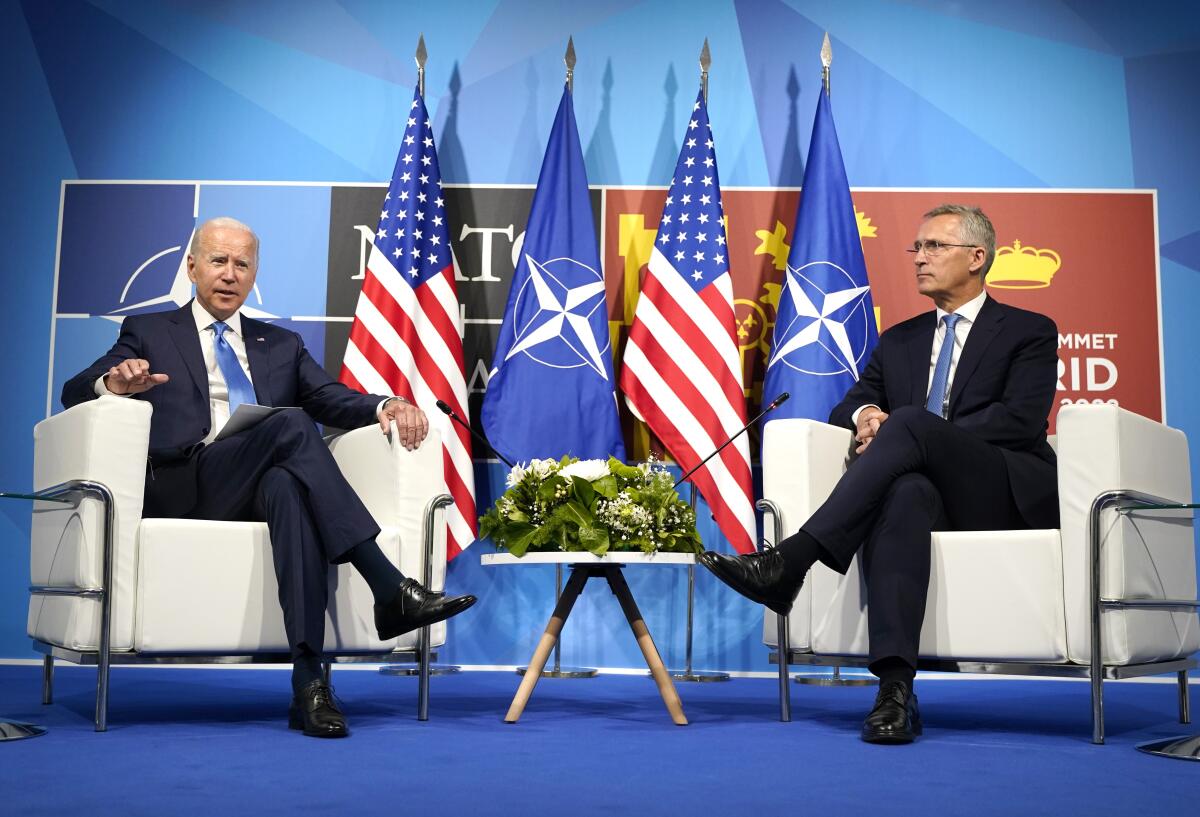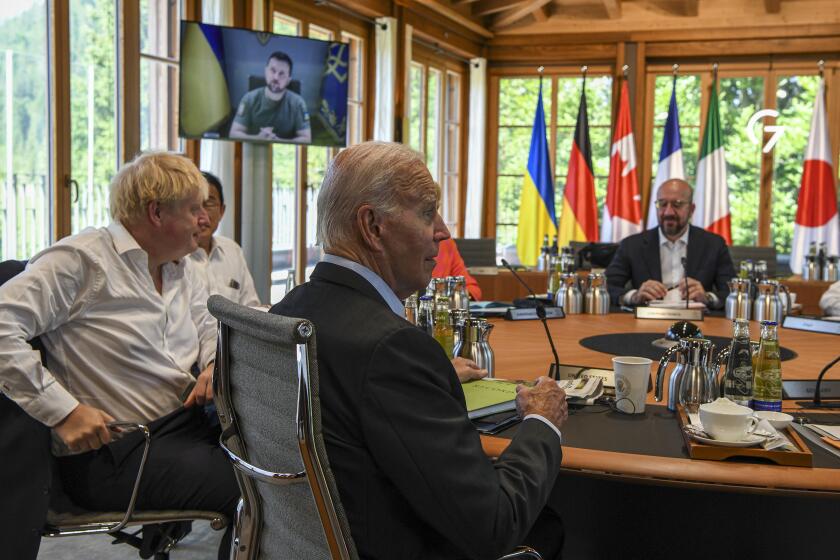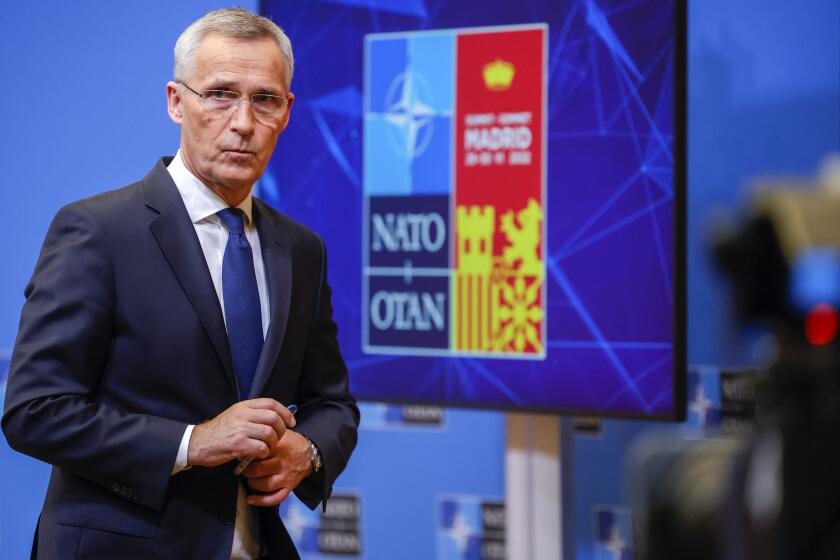Biden commits to more U.S. forces in Europe as NATO invites Sweden and Finland to join

- Share via
MADRID — Reflecting NATO’s determination to strengthen its defenses amid Russia’s war in Ukraine, President Biden announced Wednesday that the U.S. would commit more troops to Europe as the transatlantic alliance formally invited Finland and Sweden to become members.
“NATO is strong and united,” Biden said during a meeting with Jens Stoltenberg, the secretary general of the North Atlantic Treaty Organization, on the first full day of a summit here. “And the steps we’re taking during this summit, we’re going to further augment our collective strength.”
Biden emphasized that the alliance was committed to defending “every inch” of territory under its charter’s “sacrosanct” Article V, which deems an attack on a member nation to be an attack against all.
That protective umbrella is expected to cover Sweden and Finland in a historic expansion of the alliance after Turkey on Tuesday dropped its objections to the two countries joining. Once every member nation’s parliament has ratified the expansion, which is expected to take several months, NATO’s territory will include Finland’s 810-mile border with Russia — more evidence, Biden said, that attacking Ukraine has backfired on Russian President Vladimir Putin.
“Putin was looking for the Finland-ization of Europe,” Biden said, referring to Helsinki’s decades-long embrace of nonalignment for fear of angering Moscow.
But the war in Ukraine is leading to “the NATO-ization of Europe,” Biden said. “And that’s exactly what he didn’t want — but exactly what needs to be done to guarantee security for Europe.”
After Ukrainian President Volodymyr Zelensky asked G-7 leaders for new defense systems, President Biden said the U.S. would deliver.
Putin, who has given several justifications for attacking Ukraine, initially cited Ukraine’s own desire to join NATO as a pretext for his Feb. 24 invasion.
Russian missile strikes on civilian targets in Ukraine this week as Group of 7 and NATO leaders gather in Europe have sent a menacing signal to the West, crystallizing anew the importance and urgency of strengthening NATO forces in the face of Russian aggression.
Outlining the additional U.S. commitments in Europe, Biden said the U.S. would establish a new army headquarters in Poland — the first permanent American installation on NATO’s eastern flank — and put a rotational brigade combat team of 3,000 troops in Romania to enable swift deployments in the region.
Celeste Wallander, an assistant U.S. defense secretary for international security affairs, told reporters that a permanent U.S. presence in Poland would help ensure that NATO’s forces are better equipped to respond quickly when necessary.
NATO Secretary General Jens Stoltenberg says the alliance wants to increase the size of its rapid-reaction forces from 40,000 to more than 300,000.
The U.S. also will send two additional F-35 fighter squadrons to Britain and bolster “air defense and other capabilities” in Germany and Italy, Biden said.
Those announcements from Biden came less than 24 hours after he said during a meeting Tuesday with Spanish Prime Minister Pedro Sánchez that the U.S. would base two additional destroyers at its naval base in Rota, Spain.
The U.S. currently has about 100,000 troops stationed in Europe, reflecting an increase of about 20,000 since Russia attacked Ukraine. Biden called the new commitments a response “to the changing security environment, as well as strengthening our collective security.”
U.S. officials stressed that the reinforcements would not violate a 1997 NATO agreement with Russia that prohibits combat troops in Eastern Europe because the new combat deployments will be rotational, not permanent. “There has been no communication with Moscow about these changes, nor is there a requirement to do that,” said John F. Kirby, a spokesman for Biden’s National Security Council.
Breaking News
Get breaking news, investigations, analysis and more signature journalism from the Los Angeles Times in your inbox.
You may occasionally receive promotional content from the Los Angeles Times.
This NATO summit, which comes just months after an emergency gathering Biden convened at the organization’s Brussels headquarters, reflects just how dramatically Putin’s actions have changed security calculations across Europe. Stoltenberg said the war in Ukraine amounts to “the most serious security crisis we have faced since the Second World War.”
Alliance leaders meeting Wednesday and Thursday on the outskirts of Madrid are set to adopt a new strategic concept for the next 10 years — NATO’s first such update in more than a decade — that envisages additional battle groups in the east and a commitment by member nations, after years of reluctance, to devote more revenues to defense.
The concept is also likely to address the challenge posed by an increasingly powerful China. To that end, the leaders of Japan, South Korea, Australia and New Zealand have been invited for the first time to attend a NATO summit as guests.
At the start of an afternoon meeting attended by roughly three dozen world leaders, Stoltenberg was blunt in categorizing China as another adversarial state. “China does not share our values, and like Russia it seeks to undermine the international rules-based order,” he said.
Between NATO sessions, Biden met with the leaders of Japan and South Korea, calling the cooperation between the three countries “essential.”
More to Read
Get the L.A. Times Politics newsletter
Deeply reported insights into legislation, politics and policy from Sacramento, Washington and beyond. In your inbox three times per week.
You may occasionally receive promotional content from the Los Angeles Times.













